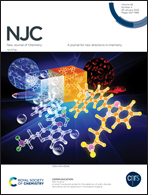In situ formation of a near-infrared controlled dual-antibacterial platform†
Abstract
Antibiotic resistance caused by long-term abuse of antibiotics has inevitably become a very serious problem and developing novel strategies to enhance the efficacy of treatments is exigent. Herein, a dual-antibacterial platform using sodium alginate (SA) and carboxymethyl chitosan (CMCS) as the framework was designed for NIR controlled pharmacotherapy and photothermal therapy of drug-resistant bacteria. The SA/CMCS solution can quickly transform into a hydrogel in response to Ca2+ and Mg2+ in biological bodies. By mixing indocyanine green (ICG) and thermosensitive drug-loaded liposomes into the solution, this designed platform can not only achieve near-infrared (NIR) controlled drug release properties but also possess dual-antibacterial capacity by combining pharmacotherapy and photothermal therapy (PTT). Local temperature rise induced by ICG will break the stability of thermosensitive liposomes, causing the release of the encapsulated drug. The in vitro antibacterial test and in vitro cytotoxicity experiment demonstrate the excellent antibacterial capacity and satisfactory biocompatibility of the prepared platform. The proposed NIR controlled dual-antibacterial platform can not only avoid bacterial resistance but also kill drug-resistant bacteria efficiently, which will provide a novel concept for the development of an intelligent antibacterial platform.



 Please wait while we load your content...
Please wait while we load your content...